Lake
Mirror anchors the downtown area of Lakeland — one of many
lovely lakes that dot the area. A grand staircase connects Lake
Mirror Park to Hollis Gardens. The neoclassically-designed gardens
inspired by similar gardens in Florence, Italy, contain some 10,000
flowers and ornamental shrubs. Here, you can also see Florida’s
history chronicled in horticulture.
Lakeland remains a walkable city full of antique shops and historic
buildings such as City Hall, built in the 1920s.
A
stop at the Historic Polk Theatre takes you back to yesteryear.
Dedicated in 1928, Polk
Theatre served as a vaudeville and movie palace. The architect,
originally from Italy, recreated an amazing Mediterranean village
in the theater. Flanked by Italianate walls with sconces, niches
and faux balconies and windows, your eye is drawn toward the stage.
After
its heyday, and by the 1980s, concerned citizens banded together
to save the Polk Theatre. But restoration wasn’t completed
until 1999. A 1927 pipe organ was rescued and renovated, and made
its way to a debut at the Polk Theatre in 2002. Today,
the Polk is a viable performing arts center, and also worth a visit
to see the all the intricate design work.
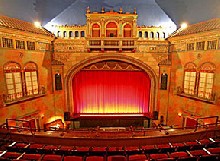
Also
near downtown, the Polk
Museum of Art houses a permanent collection of pre-Columbian
artifacts, seven other galleries and an outdoor sculpture garden.
Galleries showcase Japanese prints and ceramics, African-American
art, and a large American and European collection of 20th century
and contemporary art. Every two to three months, special exhibits
rotate such as a wonderful photography exhibit that I viewed.
This
year marks the Seventh Annual Florida Outdoor Sculpture Competition,
a joint project of the Polk Museum of Art and the Cities of Lakeland
and Winter Haven. Twenty new sculptures are now displayed on the
Lemon Street Promenade in Lakeland and the Central Park area of
Winter Haven. They remain on display through February of 2008 when
a new competition begins.
You’ll
see such creative and innovative works as dragonflies, an oversized
pair of grazing animals, a school of fish, a horse, a human figure
made out of letters of the alphabet, a figure holding a yoga pose
and several abstract pieces. Artists utilize stainless steel, painted
and sealed wood, granite, aluminum, welded metal, cast iron, reinforced
concrete and glass. Such creativity!
I
needed a reminder of what a remarkable legacy Frank Lloyd Wright
left at Lakeland’s
Florida Southern College. The famed architect designed 18 buildings
for the liberal arts college, and 12 of those were built. The first
three structures were constructed with student labor. The chapel
is the tallest, as the others are low to allow a view of Lake Hollingsworth.
Covered
walkways — Esplanades — connect all but one of Wright’s
buildings. A master of controlling space and light, Wright died
in 1959, a year after the last Esplanade was completed. This architecture
collection received a National Register of Historic Places designation
in the mid-1970s.
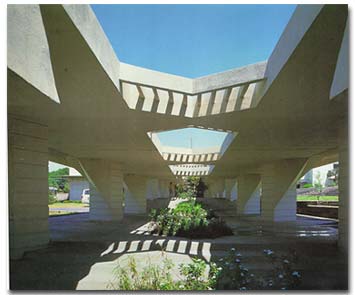
Just
outside Lakeland, I discovered a different kind of history at the
Florida
Air Museum at Sun ‘n Fun. Actually, I found out that the
museum is the Sunshine State’s official aviation museum and
education center.
Established 20 years ago, the Florida Air Museum houses more than
35 aircraft and thousands of historic artifacts that pay homage
to 100 years of flight. You’ll see Charles Lindbergh memorabilia
and an amazing array of factory-built, home-built, kit-built and
ultra-light aircraft and helicopters. One of the most impressive
collections is that of entrepreneur, innovator, and aviator Howard
Hughes. This archival collection contains never-before-seen memorabilia
of Hughes’ aviation career during the 1930s and 1940s, which
includes models of the Spruce Goose, Hughes’ personal flight
suits, medals and hundreds of items.
I’m not a flying ace, but my appreciation and interest in
aviation history also took me to Fantasy
of Flight in nearby Polk City. About 20 minutes southwest of
Disney World, this aviation attraction has 40 rare and vintage airplanes
that have been restored to flyable condition. Aerobatics competitor
and aircraft designer Kermit Weeks founded Fantasy of Flight, where
you can fly for real in a biplane — either a 1942 Boeing Stearman
PT-17 or a 1929 New Standard D-25. If you prefer less zoom, you
can always go for a three-hour hot air balloon ride and soar over
Central Florida.
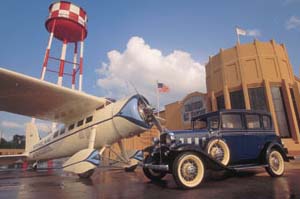
Most people who have either visited or lived in Florida for a while
know about Cypress
Gardens in Winter Haven. Long before Disney and other attractions
came to the area, Cypress Gardens is and always has been a Florida
institution. My grandfather was good friends with Dick Pope whose
vision led to the opening of Cypress Gardens back in 1936.
All these years, the lush beauty of the historic botanical gardens
and grounds has been the backdrop to the world renowned water ski
shows, leisurely boat rides and Southern Belles.
Cypress Gardens wears the banner of being the birthplace of performance
water skiing. In 1943, Julie Pope organized a water ski show for
visiting servicemen using her son Dick, Jr., daughter Adrienne,
and their friends as performers. The creative Julie Pope was also
behind another park treasure — the Southern Belles. After
the park experienced its first freeze in 1940, Mrs. Pope noticed
drooping flame vines at the entrance. She asked one of the female
staffers to don a hoop-skirted antebellum dress to stand in front
of the damaged vines and greet guests. Thus, another Cypress Gardens
tradition was born and continues today.
Unfortunately, following 9/11, attendance was so low that the park
closed in 2003. However, new owners blended the popular past with
fresh attractions, and Cypress Gardens Adventure Park reopened in
2005.
I had not been to neighboring Lake Wales in a very long time. Here
was another surprise. The historic downtown is quaint and charming.
Perhaps those words are overused but they seem to fit the bill.
You can stroll the streets, browse in the specialty shops, or stop
in a café for a bite.
On the outskirts of town, Lake
Wales Art Center is definitely worth a visit. Dating from 1927,
the building itself lingers as an architectural treasure. Originally
a catholic church, the “mission style” architecture
borrowed from Roman, Byzantine, and Renaissance details. The Lake
Wales Art Council purchased the structure in 1989 and opened the
art center in 1991. In 1990, the building was named to the National
Register of Historic Places.
In addition to art exhibitions that feature Florida artists and
a permanent collection of Central and South American artifacts,
the center serves as an educational facility. A variety of performances
are on tap throughout the year, ranging from classical and Broadway
music to dance.

Lake Wales is also home to Historic
Bok Santuary. Here, well-known Ladies Home Journal
editor, Pulitzer Prize winning author, and philanthropist Edward
Bok created a bird sanctuary and gardens that he gave to the American
people. In 1929 President Calvin Coolidge dedicated this Mountain
Lake Sanctuary and Singing Tower, now a National Historic Landmark.
With one of the world’s great carillons, the 205-foot Gothic
and art deco, marble and coquina stone tower serves as the centerpiece.
The 60-bell carillon plays concerts twice daily and during several
special events.
Boasting more than 1,000 plant types, the gardens were designed
as a meditative woodland landscape and nature preserve. This sanctuary
sits atop the Lake Wales Ridge, 298 above sea level. During ancient
times when ocean levels were much higher, a chain of islands was
formed. The upland habitat of the ridge lays claim to numerous rare
plants that aren’t found anywhere else in the world.
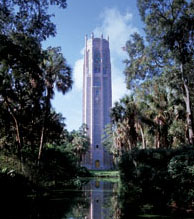
By
the way, Polk County was named for James K. Polk, the 11th president
of the US. With a history rich in citrus, cattle ranching and phosphate
mining, the county holds one of the biggest areas of farmland in
the Sunshine State, as well as 554 freshwater lakes.
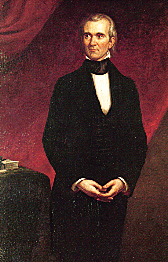
For
“must sees” in Polk County, click on this link
For
more information:
Central Florida Visitors & Convention Bureau
www.sunsational.org
and
Polk-County.com
Mapquest
map of Polk County